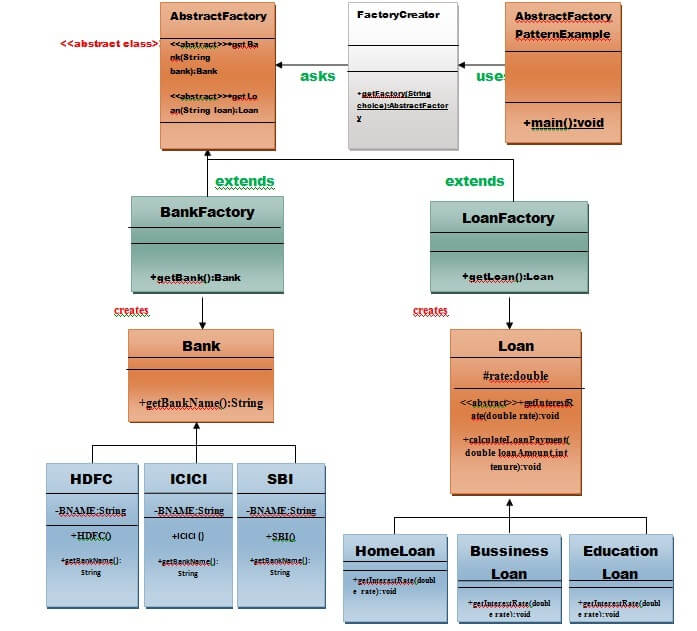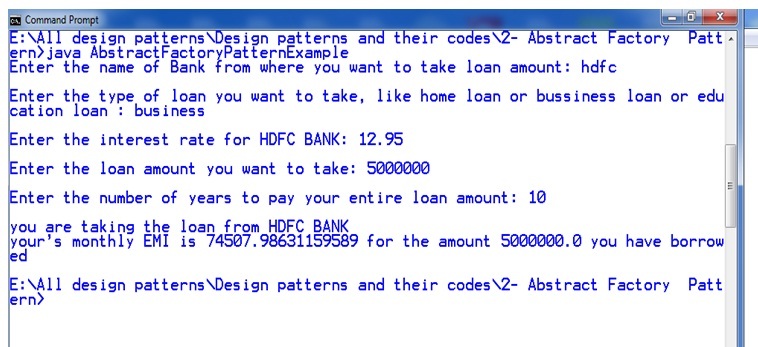Abstract Factory Pattern
Abstract Factory Pattern says that just define an interface or abstract class for creating families of related (or dependent) objects but without specifying their concrete sub-classes. Abstract Factory patterns work around a super-factory which creates other factories. This factory is also called as factory of factories.
An Abstract Factory Pattern is also known as Kit.
Advantage of Abstract Factory Pattern
- Abstract Factory Pattern isolates the client code from concrete (implementation) classes.
- It eases the exchanging of object families.
- It promotes consistency among objects.
Usage of Abstract Factory Pattern
- When the system needs to be independent of how its object are created, composed, and represented.
- When the family of related objects has to be used together, then this constraint needs to be enforced.
- When you want to provide a library of objects that does not show implementations and only reveals interfaces.
- When the system needs to be configured with one of a multiple family of objects.
UML for Abstract Factory Pattern
- We are going to create a Bank interface and a Loan abstract class as well as their sub-classes.
- Then we will create AbstractFactory class as next step.
- Then after we will create concrete classes, BankFactory, and LoanFactory that will extends AbstractFactory class
- After that, AbstractFactoryPatternExample class uses the FactoryCreator to get an object of AbstractFactory class.
- See the diagram carefully which is given below:

Example of Abstract Factory Pattern
Here, we are calculating the loan payment for different banks like HDFC, ICICI, SBI etc.
Step 1: Create a Bank interface
- import java.io.*;
- interface Bank{
- String getBankName();
- }
Step 2: Create concrete classes that implement the Bank interface.
- class HDFC implements Bank{
- private final String BNAME;
- public HDFC(){
- BNAME="HDFC BANK";
- }
- public String getBankName() {
- return BNAME;
- }
- }
- class ICICI implements Bank{
- private final String BNAME;
- ICICI(){
- BNAME="ICICI BANK";
- }
- public String getBankName() {
- return BNAME;
- }
- }
- class SBI implements Bank{
- private final String BNAME;
- public SBI(){
- BNAME="SBI BANK";
- }
- public String getBankName(){
- return BNAME;
- }
- }
Step 3: Create the Loan abstract class or interface.
- public abstract Loan{
- protected double rate;
- abstract void getInterestRate(double rate);
- default void calculateLoanPayment(double loanamount, int years) {
-
-
-
-
-
-
- double EMI;
- int n;
- n=years*12;
- rate=rate/1200;
- EMI=((rate*Math.pow((1+rate),n))/((Math.pow((1+rate),n))-1))*loanamount;
- System.out.println("your monthly EMI is "+ EMI +" for the amount"+loanamount+" you have borrowed");
- }
- }
Step 4: Create concrete classes that extend the Loan abstract class..
- class HomeLoan implements Loan{
- public void getInterestRate(double r){
- rate=r;
- }
- }
- class BussinessLoan implements Loan{
- public void getInterestRate(double r){
- rate=r;
- }
- }
- class EducationLoan extends Loan{
- public void getInterestRate(double r){
- rate=r;
- }
- }
Step 5: Create an abstract class or interface (i.e AbstractFactory) to get the factories for Bank and Loan Objects.
- interface AbstractFactory{
- default Bank getBank(String bank) [ return null; }
- default Loan getLoan(String loan) {return null; }
- }
Step 6: Create the factory classes that inherit AbstractFactory class to generate the object of concrete class based on given information.
- class BankFactory implements AbstractFactory{
- public Bank getBank(String bank){
- if(bank == null){
- return null;
- }
- if(bank.equalsIgnoreCase("HDFC")){
- return new HDFC();
- } else if(bank.equalsIgnoreCase("ICICI")){
- return new ICICI();
- } else if(bank.equalsIgnoreCase("SBI")){
- return new SBI();
- }
- return null;
- }
- }
- class LoanFactory extends AbstractFactory{
- public Loan getLoan(String loan){
- if(loan == null){
- return null;
- }
- if(loan.equalsIgnoreCase("Home")){
- return new HomeLoan();
- } else if(loan.equalsIgnoreCase("Business")){
- return new BussinessLoan();
- } else if(loan.equalsIgnoreCase("Education")){
- return new EducationLoan();
- }
- return null;
- }
- }
Step 7: Create a FactoryCreator class to get the factories by passing an information such as Bank or Loan.
- class FactoryCreator {
- public static AbstractFactory getFactory(String choice){
- if(choice.equalsIgnoreCase("Bank")){
- return new BankFactory();
- } else if(choice.equalsIgnoreCase("Loan")){
- return new LoanFactory();
- }
- return null;
- }
- }
Step 8: Use the FactoryCreator to get AbstractFactory in order to get factories of concrete classes by passing an information such as type.
- import java.io.*;
- class AbstractFactoryPatternExample {
- public static void main(String args[])throws IOException {
- BufferedReader br=new BufferedReader(new InputStreamReader(System.in));
- System.out.print("Enter the name of Bank from where you want to take loan amount: ");
- String bankName=br.readLine();
- System.out.print("\n");
- System.out.print("Enter the type of loan e.g. home loan or business loan or education loan : ");
-
- String loanName=br.readLine();
- AbstractFactory bankFactory = FactoryCreator.getFactory("Bank");
- Bank b=bankFactory.getBank(bankName);
-
- System.out.print("\n");
- System.out.print("Enter the interest rate for "+b.getBankName()+ ": ");
-
- double rate=Double.parseDouble(br.readLine());
- System.out.print("\n");
- System.out.print("Enter the loan amount you want to take: ");
-
- double loanAmount=Double.parseDouble(br.readLine());
- System.out.print("\n");
- System.out.print("Enter the number of years to pay your entire loan amount: ");
- int years=Integer.parseInt(br.readLine());
-
- System.out.print("\n");
- System.out.println("you are taking the loan from "+ b.getBankName());
-
- AbstractFactory loanFactory = FactoryCreator.getFactory("Loan");
- Loan l=loanFactory.getLoan(loanName);
- l.getInterestRate(rate);
- l.calculateLoanPayment(loanAmount,years);
- }
- }
Output




Comments
Post a Comment